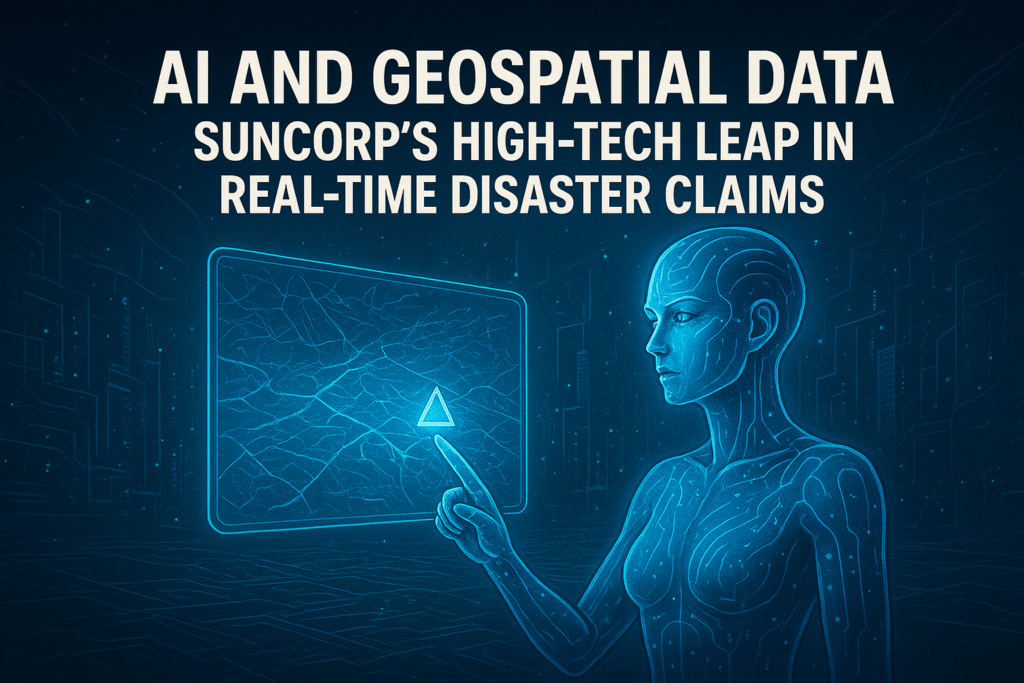Discover how Suncorp is revolutionizing insurance with AI and geospatial data. This deep dive explores their high-tech platform for real-time disaster response, faster claims processing, and proactive customer protection in the age of climate change.
The $10 Billion Problem and a High-Tech Solution
In the minutes after a catastrophic flood or a raging bushfire, the priorities are clear: save lives, protect property, and assess the damage. For insurance companies, this moment also triggers a colossal operational and humanitarian challenge. How do you quickly and accurately process tens of thousands of claims from desperate customers when the affected area is inaccessible, communications are down, and the sheer scale of the disaster is overwhelming?
For Australia, a country on the front lines of climate change, this is not a hypothetical. The 2019-2020 Black Summer bushfires and the devastating 2022 Eastern Australia floods resulted in over $10 billion in insured losses and left communities and insurers reeling. The traditional claims process—waiting for assessors to physically visit each property, often days or weeks after an event—was exposed as dangerously inadequate.
In response, one of Australia’s largest insurers, Suncorp Group, embarked on a radical technological transformation. Their mission: to leverage the power of AI and geospatial data to leapfrog from a reactive, manual claims model to a proactive, automated, and deeply empathetic system capable of operating in real-time during a disaster. This is not just an IT upgrade; it’s a fundamental reimagining of the entire insurance value chain. This article delves into the architecture, execution, and profound implications of Suncorp’s high-tech leap, a case study that is setting a new global standard for resilience in the insurance industry.
The Perfect Storm – Why the Old Model Broke Down
To appreciate Suncorp’s innovation, one must first understand the critical failures of the traditional insurance response model.
The Traditional Claims Process: A Linear Bottleneck
- Event Occurs: A cyclone makes landfall.
- Customer Notification: Customers file claims via phone or online, overwhelming call centres. Many cannot make contact due to power and network outages.
- Triaging & Logging: Staff manually log each claim based on limited information.
- Deploying Assessors: Human assessors are scheduled days or weeks later, once roads are clear and it is safe to enter the disaster zone.
- Physical Assessment: The assessor visits the property, takes photos, and evaluates the damage.
- Manual Processing: The assessor’s report is sent back, and an adjuster manually calculates the payout based on policy details.
- Settlement: Finally, a payment is approved and sent.
This process, which could take weeks or even months, was plagued by bottlenecks, immense customer anxiety, and high operational costs. In a disaster, the system simply broke.
The Humanitarian and Business Cost:
- For Customers: Prolonged uncertainty, financial strain, and immense emotional distress while waiting for a resolution.
- For Suncorp: Sky-high operational costs from mobilising thousands of assessors, potential for claims leakage (overpaying), reputational damage from slow service, and the financial hit of having uncertainty on its books for extended periods.
A new approach wasn’t just desirable; it was a strategic imperative for survival in the “new normal” of climate-induced weather events.
The Architecture of Intelligence – Deconstructing the Tech Stack
Suncorp’s solution is a sophisticated, integrated platform that fuses multiple data streams into a single source of truth. It’s a symphony of technology where AI and geospatial data are the lead performers.
1. The Foundation: Geospatial Data
This is the “where.” The platform ingests and processes vast amounts of location-based information:
- Satellite and Aerial Imagery: High-resolution photos from providers like Nearmap and Maxar, captured before, during, and after an event.
- Topographical Maps: Data on land elevation, slope, and proximity to rivers or coastlines.
- Government Data Feeds: Real-time flood maps, bushfire perimeter tracking from state fire services, and Bureau of Meteorology (BOM) weather radar and warnings.
- Property-specific Data: The precise location, footprint, and attributes of every insured property in Suncorp’s portfolio.
2. The Brain: Artificial Intelligence and Machine Learning
This is the “what.” The AI models are trained to interpret the geospatial data and automatically identify damage.
- Computer Vision: Deep learning algorithms are trained on millions of images of damaged properties. They can analyze post-event satellite and aerial imagery to detect with a high degree of accuracy:
- Roof Damage: Missing tiles, structural compromise from hail or wind.
- Flood Inundation: Water levels around a property and, crucially, in a property.
- Fire Damage: The complete destruction of a structure or scorching of surrounding land.
- Predictive Modeling: AI doesn’t just assess damage after the fact; it can predict it before an event fully unfolds. By overlaying a property’s location with real-time storm paths or flood modelling, the system can pre-emptively identify the highest-risk properties and trigger proactive customer communications.
3. The Nervous System: API Integrations and Cloud Computing
The platform doesn’t exist in a vacuum. It’s built on a modern cloud infrastructure (likely using AWS or Azure) that allows for massive, scalable data processing. It integrates via APIs with:
- Core Insurance Systems: To pull policy details and coverage limits for each property.
- Customer Communication Channels: To send automated SMS and email alerts.
- Payment Gateways: To facilitate instant digital payments.
The Real-Time Claims Revolution in Action
This is where the theoretical becomes transformational. Here’s how the platform operates during a catastrophic flood event:
Phase 1: Proactive Warning (Before the Peak)
- The BOM issues a major flood warning for Lismore, NSW.
- Suncorp’s system automatically ingests this data and runs its predictive models.
- It cross-references the forecasted flood peak with its database of properties in the inundation zone.
- Action: Automated SMS messages are sent to hundreds of customers: “Suncorp Alert: Based on BOM warning, your property at [Address] is at high risk of flooding. Please prioritise safety. Helpful tips: [Link]. We are ready to support your claim if needed.“
- Impact: Customers feel seen and supported before disaster even strikes. Suncorp manages risk and expectations.
Phase 2: Instant Assessment (During/Immediately After)
- As soon as it is safe to fly, aircraft with high-resolution cameras capture imagery of Lismore.
- This imagery is uploaded and processed by the AI’s computer vision models in hours, not weeks.
- The AI analyses each insured property, classifying damage levels (e.g., “Severe Flood Inundation – Water Above Floorboard Level”).
- Action: The system automatically generates a preliminary damage assessment and estimated cost for each valid policy.
Phase 3: Automated Triage and Payment (The “Lightning Claim”)
- For claims where the AI assessment reaches a very high confidence score (e.g., 95%+) and the policy coverage is clear, the system triggers an automated process.
- Action: The customer, who may still be without power, receives an SMS: “Suncorp here. We’ve completed a preliminary assessment of your property and approved your claim. An advance payment of $[X] has been deposited into your account to help with immediate costs. Please confirm when safe to do so.“
- Impact: A customer receives much-needed funds within 24-48 hours of the event, not weeks. This is a quantum leap in customer experience and empathy during the worst time of their lives.
Phase 4: Human-in-the-Loop for Complex Cases
- For complex claims (low AI confidence, unusual damage, complex policy terms), the system flags them for human assessors.
- Action: It provides the human assessor with the AI-generated report, pre-and post-event imagery, and a recommended course of action, drastically reducing their investigation time.
- Impact: Human expertise is focused where it is most needed, increasing overall efficiency and accuracy.
The Tangible Benefits – Beyond Faster Payouts
The advantages of this AI and geospatial data strategy cascade across the entire business.
1. Customer Experience Revolution:
- Reduced Anxiety: Proactive communication and rapid payments alleviate immense financial and emotional stress.
- Transparency: Customers are kept in the loop throughout the process.
- Trust: Suncorp builds deep, lasting loyalty by demonstrating competence and care during a crisis.
2. Operational and Financial Efficiency:
- Drastically Reduced Cycle Times: Claims are settled in days instead of months.
- Lower Assessment Costs: Reduced reliance on deploying thousands of physical assessors for every single claim.
- Improved Accuracy and Reduced Leakage: AI assessments are consistent and data-driven, minimizing the risk of human error or fraud that can lead to overpayment.
- Faster Financial Reconciliation: The company knows its liability much sooner, allowing for better financial planning and reinsurance negotiations.
3. Enhanced Risk Modelling and Pricing:
- The rich data collected feeds back into Suncorp’s actuarial models.
- They can now price risk with far greater precision at an individual property level rather than a generic postcode level, leading to fairer premiums.
4. Strategic Advocacy for Resilience:
- Armed with precise data on which properties are most vulnerable, Suncorp has moved beyond being just a payer of claims to an advocate for mitigation.
- They can provide data-driven insights to governments on land-use planning and invest in programs that help customers strengthen their homes against future disasters, ultimately reducing community-wide risk.
Challenges and the Road Ahead
The journey is not without its hurdles.
- Data Privacy and Security: Handling precise location and imagery data requires robust cybersecurity and clear customer consent protocols.
- Algorithmic Bias: The AI models must be constantly audited to ensure they don’t perpetuate biases (e.g., failing to accurately assess damage on certain roof types common to lower-income areas).
- The “Human Touch” Balance: While automation is powerful, knowing when and how to inject human empathy into the process is crucial. A total loss claim for a family home requires a different response than a minor roof repair.
- Regulatory Scrutiny: Insurance is a highly regulated industry. Automated decision-making must be explainable and compliant with financial services regulations.
The future will involve even more predictive capabilities, perhaps integrating IoT data from smart home devices, and a greater shift towards preventing losses rather than just paying for them.
Conclusion: A New Paradigm for a Riskier World
Suncorp’s strategic investment in AI and geospatial data is far more than a technological upgrade; it is a fundamental recalibration of the social contract of insurance. It moves the industry from a historically adversarial, reactive model to a partnership-based, proactive force for stability.
In the face of escalating climate risk, this is not merely a competitive advantage—it is a blueprint for resilience. It demonstrates how technology, when applied with a customer-centric vision, can transform a legacy industry into a agile, empathetic, and essential service. Suncorp’s high-tech leap in real-time disaster claims is no longer a pilot project; it is the new operational reality, setting a dauntingly high bar for the global insurance industry and offering a beacon of hope for communities living on the frontline of a changing climate.


